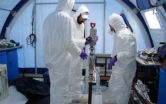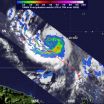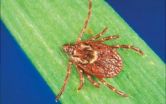(Press-News.org) West Nile virus, Lyme disease, dengue fever, and plague are examples of "vector-borne zoonotic diseases," caused by pathogens that naturally infect wildlife and are transmitted to humans by vectors such as mosquitoes or ticks.
According to Marm Kilpatrick, who studies the ecology of infectious diseases at the University of California, Santa Cruz, a broad range of human activities can affect the spread of zoonotic diseases. In an article in the December 1 issue of the British medical journal Lancet, Kilpatrick and coauthor Sarah Randolph of the University of Oxford describe how widespread land-use change, globalization of trade and travel, and social upheaval are driving the emergence of zoonotic vector-borne diseases around the world. The article is part of a special series of papers focused on emerging zoonotic diseases.
"This collection of papers offers a bridge between ecologists and clinicians whose combined efforts are needed to address the ongoing challenges of emerging zoonotic diseases," said Kilpatrick, an assistant professor of ecology and evolutionary biology at UC Santa Cruz.
Emerging infectious diseases can be roughly split between introduced and locally emerging diseases. Introduced diseases arise from the spread of a pathogen to a new location, as when West Nile virus arrived in New York in 1999 and subsequently spread across North America. Locally emerging diseases increase in importance in areas where they are endemic, as with Lyme disease in the United States over the past three decades. These two types of emerging diseases can differ markedly with respect to infection dynamics, or the number of cases over time, Kilpatrick said.
"Introduced diseases often cause a big spike in infections and then decrease substantially. Locally emerging diseases often show a steady, sustained increase," he said.
The movement of pathogens by global trade and travel results in the emergence of diseases in new regions. Once established, introduced pathogens often evolve to take advantage of their new environment, including new hosts and vectors. With so much of the landscape shaped by human activities, pathogens may thrive by infecting hosts and vectors that do well in manmade environments.
"Increasing human population and the urbanization and agricultural intensification of landscapes puts strong selective pressure on vector-borne pathogens to infect humans and be transmitted by vectors and hosts that live around humans," Kilpatrick said.
Emergence of endemic vector-borne diseases can result from changes in land use, such as expansion of people into new habitats, or environmental changes affecting the wild animals that serve as natural hosts or the insect vectors that spread the disease to humans. Although vector-borne diseases are highly sensitive to climate, climate change does not appear to be a major driving force behind emerging diseases, the authors said.
"So far, climate change has been a relatively minor player compared to land use and socioeconomic factors in the emergence of vector-borne disease," Kilpatrick said.
Social and economic changes, ranging from economic downturns to displacement of populations by armed conflict, frequently precipitate disease outbreaks through their impacts on public health systems, sanitation systems, behavioral patterns, and uses of natural environmental resources. One example cited in the article is a large upsurge of tick-borne encephalitis after an economic downturn in eastern Europe resulted in more people harvesting food from forests.
The incidence of any vector-borne disease involves a complex interplay of multiple factors affecting animal hosts, vectors, and people. Kilpatrick and Randolph emphasize that control of these diseases requires combined efforts by clinicians and public health officials to treat patients, promote behavior likely to minimize the risk of infection, and advise on efforts to reverse the ecological drivers of transmission through vector control, urban planning, and ecological restoration.
Publication of the Lancet series coincides with an Institute of Medicine (IOM) symposium on Emerging Infections, Microbial Threats to Health, and the Microbiome, December 11-12 in Washington, D.C. The symposium marks the 20th anniversary of an influential 1992 IOM report on emerging diseases.
"Humans are altering the environment and moving themselves and other organisms around the globe at an ever-increasing pace," said Sam Scheiner, program director for the Ecology and Evolution of Infectious Diseases program at the National Science Foundation (NSF), a joint effort with the National Institutes of Health (NIH). "That has led to a growing disease threat. These papers show how and why that's happening, and what we need to know to ease the disease burden."
###Kilpatrick's research on the ecology of infectious diseases is supported by grants from NSF and NIH.
Emerging vector-borne diseases create new public health challenges
Land-use change, globalization of trade and travel, and social upheaval are driving the emergence of diseases in many regions, experts say
2012-12-01
ELSE PRESS RELEASES FROM THIS DATE:
Ancient microbes survive beneath the icy surface of Antarctic lake
2012-12-01
Researchers funded by the National Science Foundation (NSF) describe in a new publication a viable community of bacteria that ekes out a living in a dark, salty and subfreezing environment beneath nearly 20 meters of ice in one of Antarctica's most isolated lakes.
The finding could have implications for the discovery of life in other extreme environments, including elsewhere in the solar system.
If, as the researchers postulate, the bacteria survive purely from chemical reactions, as opposed to drawing energy from the sun or other sources, "this gives us an entirely ...
Vitamin D tied to women's cognitive performance
2012-12-01
Two new studies appearing in the Journals of Gerontology Series A: Biological Sciences and Medical Sciences show that vitamin D may be a vital component for the cognitive health of women as they age.
Higher vitamin D dietary intake is associated with a lower risk of developing Alzheimer's disease, according to research conducted by a team led by Cedric Annweiler, MD, PhD, at the Angers University Hospital in France.
Similarly, investigators led by Yelena Slinin, MD, MS, at the VA Medical Center in Minneapolis found that low vitamin D levels among older women are associated ...
Geoscientists cite 'critical need' for basic research to unleash promising energy resources
2012-12-01
Developers of renewable energy and shale gas must overcome fundamental geological and environmental challenges if these promising energy sources are to reach their full potential, according to a trio of leading geoscientists. Their findings will be presented on Dec. 4, at 5:15 p.m. (PT), at the fall meeting of the American Geophysical Union (AGU) in San Francisco in Room 102 of Moscone Center West .
"There is a critical need for scientists to address basic questions that have hindered the development of emerging energy resources, including geothermal, wind, solar and ...
NASA sees 'hot towers' in intensifying Typhoon Bopha
2012-12-01
Bopha intensified into a typhoon today, Nov. 30, as it continues to affect the islands in Micronesia in the western North Pacific Ocean. NASA's TRMM satellite captured rainfall data of Bopha and noticed "Hot Tower" thunderstorms as it was intensifying from a tropical storm into a typhoon.
When NASA and the Japanese Space Agency's Tropical Rainfall Measuring Mission (TRMM) satellite passed over Bopha twice on Nov. 29, and the later data showed that the area of heaviest rainfall had expanded and was still south of the center of circulation. The heaviest rainfall was occurring ...
Emerging vector-borne diseases create new public health challenge
2012-12-01
Human activities are advancing the spread of vector-borne, zoonotic diseases such as West Nile virus, Lyme disease and dengue fever, report scientists publishing a series of papers today in the journal The Lancet.
Vector-borne zoonotic diseases result from disease-causing agents or pathogens that naturally infect wildlife, and are transmitted to humans by carriers such as mosquitoes and ticks. In short, they're diseases transmitted between animals and humans.
Widespread land-use change, globalization of trade and travel, and social upheaval are driving the emergence ...
ORNL develops lignin-based thermoplastic conversion process
2012-12-01
Turning lignin, a plant's structural "glue" and a byproduct of the paper and pulp industry, into something considerably more valuable is driving a research effort headed by Amit Naskar of Oak Ridge National Laboratory.
In a cover article published in Green Chemistry, the research team describes a process that ultimately transforms the lignin byproduct into a thermoplastic – a polymer that becomes pliable above a specific temperature. Researchers accomplished this by reconstructing larger lignin molecules either through a chemical reaction with formaldehyde or by washing ...
Preventing 'Cyber Pearl Harbor'
2012-12-01
Cyber attacks that have long caused major work disruption and theft of private information are becoming more sophisticated with prolonged attacks perpetrated by organized groups. In September 2012, Bank of America, Citibank, the New York Stock Exchange, and other financial institutions were targets of attacks for more than five weeks. Defense Secretary Leon E. Panetta warned that the United States was facing the possibility of a "cyber-Pearl Harbor" and was increasingly vulnerable to foreign computer hackers who could disrupt the government, utility, transportation, and ...
NASA's TRMM satellite video reveals 2012 hurricane season rainfall
2012-12-01
The 2012 Atlantic Hurricane season was a busy one as there were 19 tropical cyclones. A new NASA animation using data from the Tropical Rainfall Measuring Mission satellite known as TRMM shows rainfall from tropical cyclones in the western Atlantic, as measured from space.
The TRMM satellite has now been making highly accurate measurements of rainfall from space for fifteen years since it launched in Nov. 1997. TRMM is a joint mission between NASA and the Japanese space agency, JAXA.
TRMM can be used to calibrate rainfall estimates from other satellites. Those rainfall ...
In schizophrenia patients, auditory cues sound bigger problems
2012-12-01
Researchers at the University of California, San Diego School of Medicine and the VA San Diego Healthcare System have found that deficiencies in the neural processing of simple auditory tones can evolve into a cascade of dysfunctional information processing across wide swaths of the brain in patients with schizophrenia.
The findings are published in the current online edition of the journal Neuroimage.
Schizophrenia is a mental disorder characterized by disturbed thought processes and difficulty in discerning real from unreal perceptions. Common symptoms include auditory ...
Steroid injection linked with significant bone loss in postmenopausal women treated for back pain
2012-12-01
DETROIT – Postmenopausal women suffered significant bone density loss in their hip after they were treated with an epidural steroid injection for back pain relief, according to a Henry Ford Hospital study
Bone density loss after six months was six times greater when compared to the typical bone density loss seen in a year in a postmenopausal woman who doesn't receive steroid injection, researchers say.
Shlomo Mandel, M.D., a Henry Ford orthopedic physician and the study's lead author, says physicians should exercise caution prescribing an epidural steroid for select ...
LAST 30 PRESS RELEASES:
Numbers in our sights affect how we perceive space
SIMJ announces global collaborative book project in commemoration of its 75th anniversary
Air pollution exposure and birth weight
Obstructive sleep apnea risk and mental health conditions among older adults
How talking slows eye movements behind the wheel
The Ceramic Society of Japan’s Oxoate Ceramics Research Association launches new international book project
Heart-brain connection: international study reveals the role of the vagus nerve in keeping the heart young
Researchers identify Rb1 as a predictive biomarker for a new therapeutic strategy in some breast cancers
Survey reveals ethical gaps slowing AI adoption in pediatric surgery
Stimulant ADHD medications work differently than thought
AI overestimates how smart people are, according to HSE economists
HSE researchers create genome-wide map of quadruplexes
Scientists boost cell "powerhouses" to burn more calories
Automatic label checking: The missing step in making reliable medical AI
Low daily alcohol intake linked to 50% heightened mouth cancer risk in India
American Meteorological Society announces Rick Spinrad as 2026 President-Elect
Biomass-based carbon capture spotlighted in newly released global climate webinar recording
Illuminating invisible nano pollutants: advanced bioimaging tracks the full journey of emerging nanoscale contaminants in living systems
How does age affect recovery from spinal cord injury?
Novel AI tool offers prognosis for patients with head and neck cancer
Fathers’ microplastic exposure tied to their children’s metabolic problems
Research validates laboratory model for studying high-grade serous ovarian cancer
SIR 2026 delivers transformative breakthroughs in minimally invasive medicine to improve patient care
Stem Cell Reports most downloaded papers of 2025 highlight the breadth and impact of stem cell research
Oxford-led study estimates NHS spends around 3% of its primary and secondary care budget on the health impacts of heat and cold in England
A researcher’s long quest leads to a smart composite breakthrough
Urban wild bees act as “microbial sensors” of city health.
New study finds where you live affects recovery after a hip fracture
Forecasting the impact of fully automated vehicle adoption on US road traffic injuries
Alcohol-related hospitalizations from 2016 to 2022
[Press-News.org] Emerging vector-borne diseases create new public health challengesLand-use change, globalization of trade and travel, and social upheaval are driving the emergence of diseases in many regions, experts say




